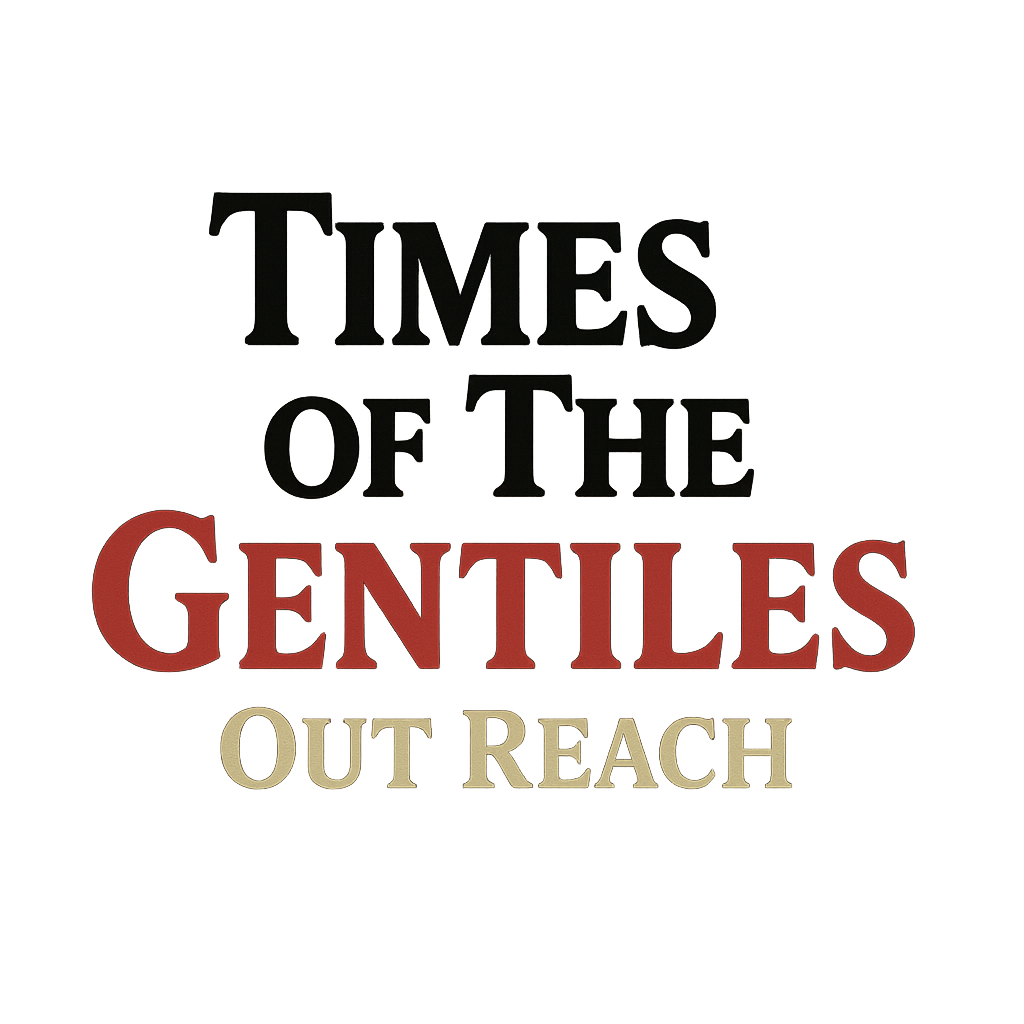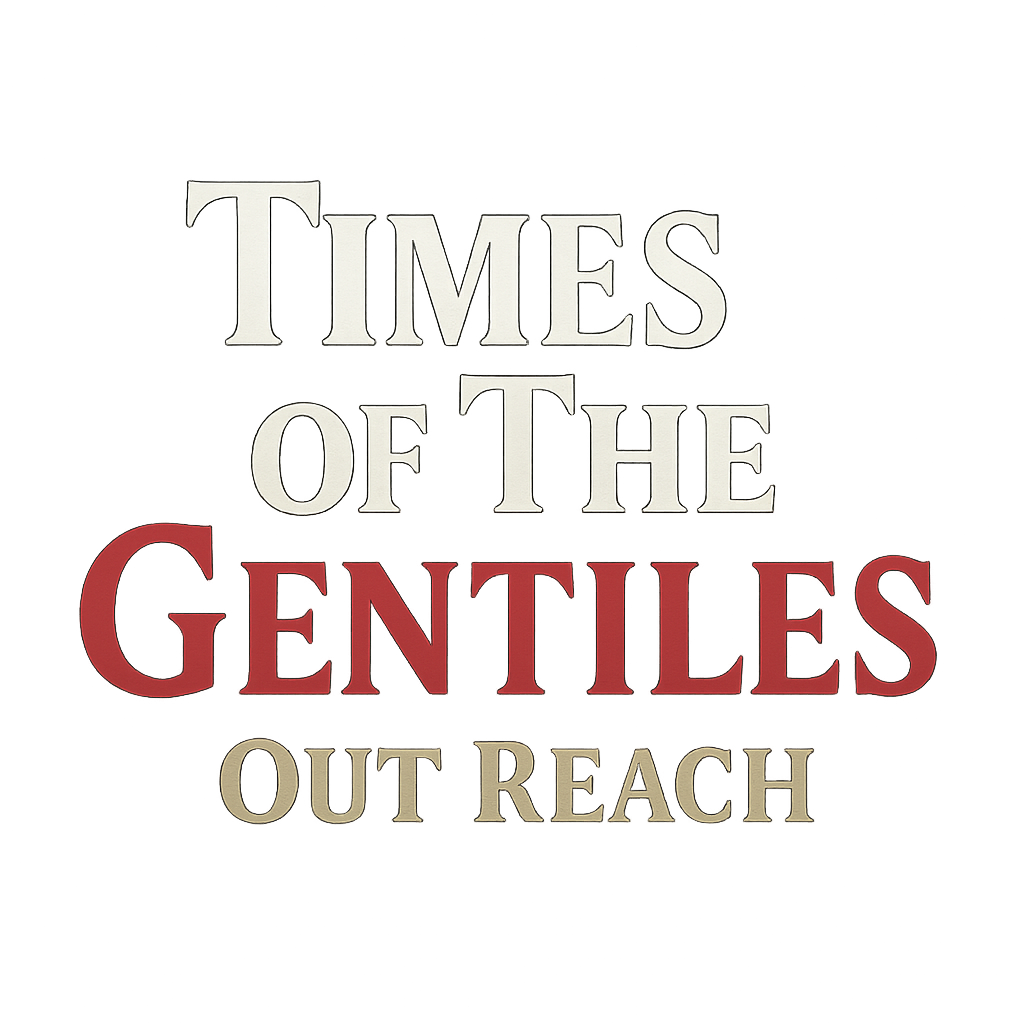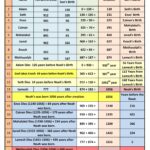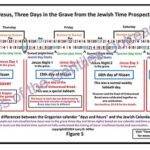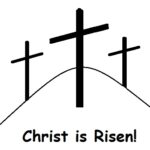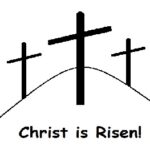How was Jesus in the Grave Three Days?
In my years as a Christian, I have found some things, which I have been taught, to be vague and puzzling. One of these things has been the time dilemma stemming from being taught that Jesus died on the cross on Friday and arose from the tomb on Sunday morning. I have been hard pressed to get three days and three nights in the grave from this telling of the story. Read more to find out how the writers of the accounts of Jesus’ crucifixion had a different concept of time than you and I. You will be Amazed.
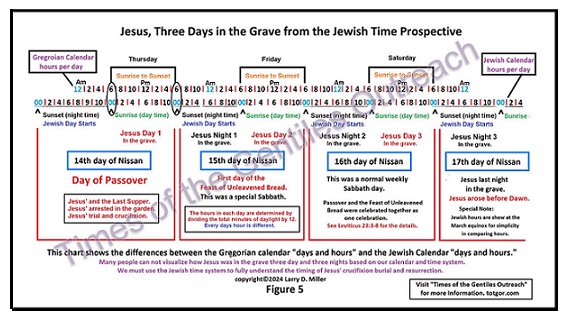
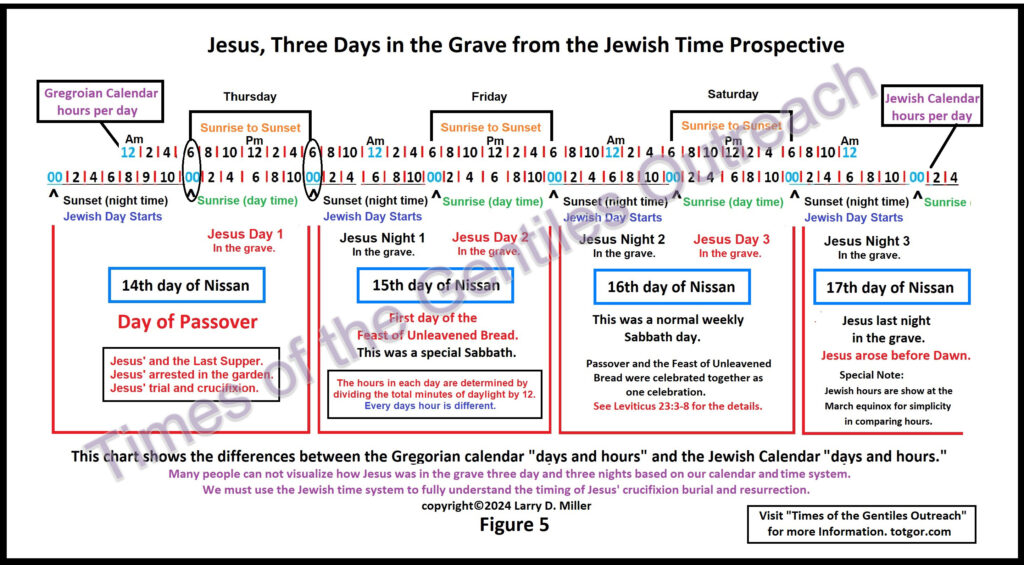
Jesus Three Days in the Grave
Introduction
In my years as a Christian, I have found some things, which I have been taught, to be vague and puzzling. One of these things has been the time dilemma stemming from being taught that Jesus died on the cross on Friday and arose from the tomb on Sunday morning. I have been hard pressed to get three days and three nights in the grave from this telling of the story. I have taken it by faith but always thought there had to be a more precise explanation. In my studies, I have found there is a more precise explanation.
The times and dates represented in the Old and New Testaments are based on the Jewish Calendar and their definitions of days, hours, months and years and not by our definition of days, hours, months and years as defined in our Gregorian calendar system which is accepted as; “today’s internationally accepted civil calendar”[1]. As we are told in the website Time and Date, the Gregorian calendar is the calendar used for international coordination and transactions. The problems we have with differences in calendars are the same problem we have with languages. For instance, what if all international pilots and air traffic controllers only spoke their own native language? It just would not work, every airline flight work be at risk. English is the international pilot’s language which helps insure airline safety around the world. Pilots must communicate with words and concepts that are understood by every pilot no matter their native language. Let’s look at this concept with calendars.
What does the word “day” really mean in the two different cultures and languages, both in our culture today and back in the time of the bible? From this study you will learn some of these differences that have confused bible students through the ages.
In our culture we say, we start our “day” in the morning, when the sun comes up, with our first cup of coffee. But our calendar day actually began at midnight, our “yesterday” ended at midnight. Our night time hours are divided between two different “days” in a 24 hour period. Even here in our culture the word “day” has varied meanings and uses.
We will learn how in Biblical times and in the modern Jewish calendar the time “a new day” begins is in the evening, at sunset not at midnight as we reckon time as being the start of a new day. Does this seem confusing? Well it is. My goal here is to help you make sense of it all.
Without a basic understanding of these differences we cannot fully understand the Jewish concepts of Jesus being in the grave three days and three nights. (Note: A more detailed explanation of these calendars systems is given in the Supplemental Section at the end of the article.)
[1] www.timeanddate.com/calendar/Gregorian-calendar.html 02/03/2016 “The Gregorian Calendar”
Jewish Definition of a Day
Most biblical scholars believe Moses, to be the writer of Genesis and many of the Jewish Laws and traditions. I want to make it clear Moses did not author Genesis, he only pinned it. God is the author of the entire Bible, which was pinned by men who were many times directly given the text by God and other times were supernaturally inspired and lead by God’s Holy Spirit to write and record the stories and events in the Bible. Now let’s see how God establishes time definitions used by the Jewish nation as recorded in the Bible starting with Genesis chapter one.
Writing thru the inspiration of the Holy Spirit and words directly from God in Genesis, Exodus, Leviticus and the other books of Moses, he establishes the Calendar of the Jewish nation. This includes the Year, Month, Day and Hour. The Jewish calendar by tradition and by the need to be strictly adhering to the “Letter of the Law” became a very complex Calendar System under the Jewish Sanhedrin as we will see, however, God made the Jewish day very simple.
It starts in Genesis 1:1;
“1 In the beginning God created the heaven and the earth.
2 And the earth was without form, and void; and darkness was upon the face of the deep. And the Spirit of God moved upon the face of the waters.
3 And God said, Let there be light: and there was light.
4 And God saw the light, that it was good: and God divided the light from the darkness.
5 And God called the light Day, and the darkness he called Night. And the evening and the morning were the first day.” Genesis 1:1-5 KJV.
“8 And God called the firmament Heaven. And the evening and the morning were the second day.” Genesis 1:8 KJV.
“13 And the evening and the morning were the third day.” Genesis 1:13 KJV.
“19 And the evening and the morning were the fourth day.” Genesis 1:19 KJV.
“23 And the evening and the morning were the fifth day.” Genesis 1:23 KJV.
“31 And God saw every thing that he had made, and, behold, it was very good. And the evening and the morning were the sixth day.” Genesis 1:31 KJV.
Notice that “darkness was upon the face of the deep” then God created light. So the concept that darkness came before light is reflected in creation. In God’s revelation of creation to Moses the precept or concept of “night comes before day” becomes apparent. The statement,” And the evening and the morning were the first day” establishes in the Jewish mind the concept that evening (sundown/sunset) is the start of the day. This is foundational in understanding Bible text.
Notice in Genesis 1:5 it says,” 5 And God called the light Day, and the darkness he called Night. And the evening and the morning were the first day.” We see God used the term “day” in two different ways. He use the word “day” to describe the daylight portion of a day, then used “day” as being the combination of the evening and morning.
When Jesus said he would be in the grave three days and three nights, he meant three daylight hours and three nighttime hours as we will see in this study.
My information about the Jewish day and calendar system presented in this article is based on the Bible and explanations found at chabad.org where they summarize the definition of a Jewish day saying, “According to the Jewish calendar, not only Jewish holidays begin at nightfall but every day does.”[1] More information on the Jewish calendar and calendar in general can be found in the Supplemental information at the end of this article.
To be even more confusing chabad.org states, “While a day starts and ends at nightfall, the exact moment when night — and the next calendar date – begins is not clear. The twilight period, from sunset (“shkiah”) until three stars are visible in the sky (“tzeit hakochavim”), is an “iffy” time period, known as “bein hashmashot”.[2] They go on to say that a Rabbi must be consulted when events happen in this time period. For example, if a Jewish male is born or a Jewish person dies during certain twilight times only a Rabbi can determine the actual day of the death or birth. This has to been done so that required ceremonies can be carried out on the proper days as required by Jewish Law.[3] See the referenced websites provided, for all the implications of this twilight[4] time period. Even today finding a universally agreed upon time for twilight[5] can be confusing. In Figure 1 you can find three modern definitions of twilight used today by different modern groups. See Figure 1 below. We are told the Jewish nation used their own definition for twilight during biblical times. Only the priest could make the call for when the new day began.
Let’s see how this determined the timing of events in Jewish religious ceremonies.
[1] www.chabad.org/libary/article_cdo/aid/160961/jewish/Why-do-Jewish-holidays-begin-at-nightfall.htm 02/09/2016
[2] www.chabad.org/libary/article_cdo/aid/526873/jewish/The-Jewish-Day.htm 02/09/2016
[3] www.chabad.org/libary/article_cdo/aid/526873/jewish/The-Jewish-Day.htm 02/09/2016
[4] https://www.weather.gov/fsd/twilight National Weather Service retrieved 03/16/2025
[5] https://aa.usno.navy.mil/faq/RST_defs US Naval Observatory retrieved 03/16/2025
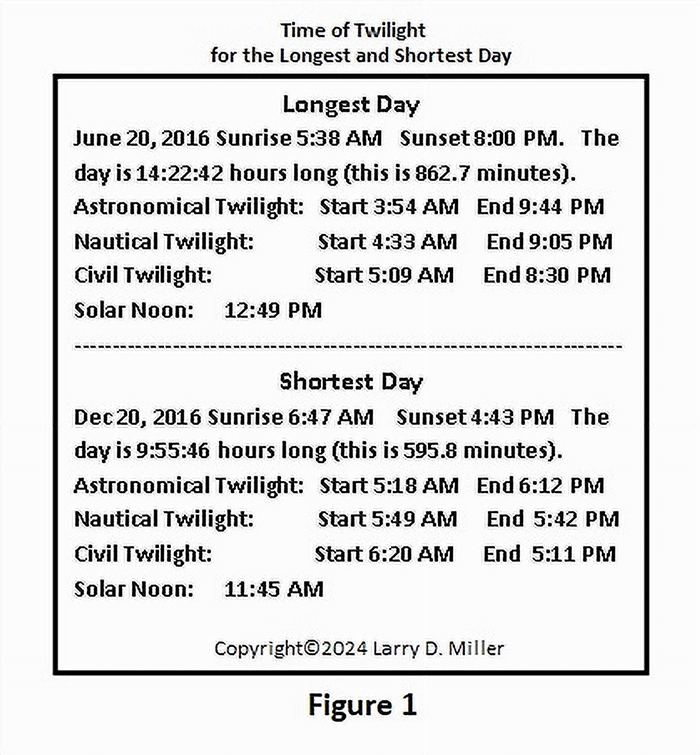
Jewish Passover and the Feast of Unleavened Bread
Most Christians have been taught, or should have been taught, that Jesus was/is our perfect sacrifice for our sins. Those raised under Christian teaching generally understand this concept; however from my many years in Christian churches I find few Christian’s truly grasp this precept of our faith. I also have found few Christian’s can give a reasonable explanation of the sacrificial process of the Old Testament. Those of you that have never been in church or have never been taught what this precept implies I need to briefly cover the Jewish celebration of Passover and the Feast of Unleavened Bread and how Jesus’ death on the cross fulfilled the requirements of this Passover sacrifices and its commemorations.
To understand this Jewish celebration let us look at Gods original instructions to Moses and children of Israel about Passover then how later God makes the Passover into a Holy Festival with special times for feast and worship during the celebration.
Some important things to notice in our discussions will be: First, the specific days each event was to be carried out, next the time of day each event was to start on the Jewish system of time, then how these awkwardly translates to our Gregorian calendar system.
Before you continue it would helpful to read and study all of Exodus chapters 1 through 12 to see the events leading up to the first Passover. Those who are familiar with the background story here is the main part we need to know.
Exodus 12:1-11
God’s original instructions to Moses in Egypt
“1 And the LORD spake unto Moses and Aaron in the land of Egypt, saying,
2 This month shall be unto you the beginning of months: it shall be the first month of the year to you.
3 Speak ye unto all the congregation of Israel, saying, In the tenth day of this month they shall take to them every man a lamb, according to the house of their fathers, a lamb for an house:
4 And if the household be too little for the lamb, let him and his neighbour next unto his house take it according to the number of the souls; every man according to his eating shall make your count for the lamb.
5 Your lamb shall be without blemish, a male of the first year: ye shall take it out from the sheep, or from the goats:
6 And ye shall keep it up until the fourteenth day of the same month: and the whole assembly of the congregation of Israel shall kill it in the evening.
7 And they shall take of the blood, and strike it on the two side posts and on the upper door post of the houses, wherein they shall eat it.
8 And they shall eat the flesh in that night, roast with fire, and unleavened bread; and with bitter herbs they shall eat it.
9 Eat not of it raw, nor sodden at all with water, but roast with fire; his head with his legs, and with the purtenance thereof.
10 And ye shall let nothing of it remain until the morning; and that which remaineth of it until the morning ye shall burn with fire.
11 And thus shall ye eat it; with your loins girded, your shoes on your feet, and your staff in your hand; and ye shall eat it in haste: it is the LORD’S passover.” Exodus 12:1-11 KJV.
From the text of Exodus 12:1-11 we will observe some key points about the Passover
Key points to observe are:
1. God told the Israelites to select a lamb on the tenth day and keep it until the fourteenth day. This was enough time to select from their flocks or the purchase an acceptable lamb for the sacrifice. These ten days were also time for Israel and the Egyptians to contemplate God’s coming judgment on Egypt and any Israelite who would not revere God and follow his commands. This final plague from God was the killing of all the first born males of Egypt, human and animals, for Pharaoh’s refusal to set the Israelites free.
2. In verse 6 God instructed them to “keep it up until the fourteenth day of the same month “. God gave from the tenth day until the fourteenth day to give everyone time to inspect the lamb for defects and prepare for the atonement sacrifice. God gave and still gives man foreknowledge of the consequences of not believing Gods warnings, giving mankind time to accept His provision or reject His provision for dealing with our disbelief and rebellion.
3. Again, in verse 6, God said, “Israel shall kill it in the evening”. From our previous study, remember nighttime (evening) is the beginning of the Jewish day. This means they keep the lamb until after dark (the beginning of the day) on the fourteenth day then they were to kill it, at the start of the day which was just after dark.
4. God told them in verse 11 that this is the “LORD’S Passover”. The night the death angel went through Egypt was only a one night event. It started at the beginning of the “day”, sunset. In our thinking we would say we got the sacrifice ready that afternoon and killed it that night of the same day, but this was the start of a whole new day, and a night time event, for the Israelites, they were to be ready to travel and get out of Egypt at day break of the same day.
Now let us look at how the Passover became a weeklong celebration which God established thru Moses while they were in the wilderness. Read and study Leviticus Chapter 23.
God instruction on how to observe the “Passover and the Feast of Unleavened Bread” for the generations to come.
“3 Six days shall work be done: but the seventh day is the sabbath of rest, an holy convocation; ye shall do no work therein: it is the sabbath of the LORD in all your dwellings.
4 These are the feasts of the LORD, even holy convocations, which ye shall proclaim in their seasons.
5 In the fourteenth day of the first month at even (evening) is the LORD’S passover.
6 And on the fifteenth day of the same month is the feast of unleavened bread unto the LORD: seven days ye must eat unleavened bread.
7 In the first day ye shall have an holy convocation: ye shall do no servile work therein.
8 But ye shall offer an offering made by fire unto the LORD seven days: in the seventh day is an holy convocation: ye shall do no servile work therein.” Leviticus 23:3-8 KJV.
Key points to observe here in Leviticus are:
A. Notice in Verse 3 how Gods describes the six days of a normal week then instructs the seventh day to be a “Sabbath”, and then defines it as a day of rest and places restrictions on people’s activities. Any day that met this definition or requirements, God refers to it as a Sabbath day. Gods gave three directives for the seventh day Sabbath:
1. A day “of rest”.
2. It is called “an holy convocation”, a holy gathering. Convoke is defined as: “to call together to a meeting” per Merriam-Webster dictionary.
3. The people were commanded that they “ye shall do no servile work therein.” KJV translation, or in a more modern translation, “You are not to do any work; wherever you live” NIV translation.
B. In Verses 5, the “LORD’S Passover” shall be observed on the “fourteenth day of the first month”.
C. In verse 6, the “Feast of Unleavened Bread” shall be observed on the “fifteenth day of the same month”, and is to continue for “seven days” and they “must eat unleavened bread”.
D. Note the “LORD’S Passover” and the “Feast of Unleavened Bread” are two different events with different instructions, the seven day Feast of Unleavened Bread was a celebration of the Passover event and their leaving the bondage of Egypt through the power and direction of God.
E. In verse 7 God says the first day of the “Feast of Unleavened Bread” is to be “an holy convocation”, which is a “Sabbath day”. Moreover, God reiterates, “ye shall do no servile work therein”.
F. Offerings and special meals (meals with unleavened bread) were to be made every day during the seven days, verse 8.
G. Verse 8, the seventh day is to be “an holy convocation”, a “Sabbath day”.
So here in Exodus 12 and Leviticus 23, we can clearly see how the Jews were to celebrate these festivals from that time forward and during the time of Jesus. As we will see next, Jesus and his disciples were in compliance of these religious regulations before, during and after his crucifixion and resurrection.
Jesus in the Grave Three Days and Three Nights
Jesus’ First day in the Grave
Jesus declared in Matthew 12:40: “For as Jonas was three days and three nights in the whale’s belly; so shall the Son of man be three days and three nights in the heart of the earth. ”Matthew 12:40 KJV.[1] Many people including myself have been confused as to how this could be in light of Christian traditions which says Jesus died Friday (Good Friday) and rose on Sunday morning (two nights), as I state in the beginning. Now let us put together what we have learned and determine the sequences of events leading up to the crucifixion of Jesus.
Below in Matthew 26, Mark 14 and Luke 22 we will read the accounts of Jesus and his disciples preparing for the Passover meal. Again, we must observe the details of what we read and think like a Jew of Jesus’ day. The Jewish people knew that the Passover was the day before the Feast of Unleavened Bread, as was described in Leviticus 23. However in the New Testament the usage of these two terms is somewhat confusing. We must first look at the use of the word “Passover” and the phrase “Feast of Unleavened Bread” in these passages. We find them used interchangeably.
First we will see the term “Passover” is used in Matthew 26:17 and Mark 14:12 as a meal, just as we would talk about Christmas dinner. The second use of the word “Passover” is in Luke 22:7, in connection with “day of unleavened bread” which could be confused with the “Feast of Unleavened Bread”. All the meals for these eight days were required to have only unleavened bread. So we need to be clear on the language and terms used. Remember each of these writers were writing to different groups of people of their generation each with their own cultural vocabularies.
Today, I see were some Jews uses “Passover” as the shortened name for the total eight days of Passover and the Feast of Unleavened Bread combined together just as we read. This can be seen in Figure 3, the calendar for April 2016 showing the Jewish / Gregorian calendar together, where each day has the title Passover at the top. (Figure 3 and the details of this information are in the Supplemental Information at the end of this article.) Luke makes it very clear when he says in Luke 22:1-2 “1 Now the feast of unleavened bread drew nigh, which is called the Passover. 2 And the chief priests and scribes sought how they might kill him; for they feared the people.” Luke 22:1-2 KJV. Here we see Luke giving a quick explanation to his readers about these being two events. His gospel was to the Greek or gentile world of his day, who like us, may not have understood the complete Jewish context.
In Leviticus God made the distinction between the Passover being one day and the Feast of Unleavened Bread being seven days of feasting. In Matthew 26:17, Mark 14:12 and Luke 22:7 each lump the Passover and the Feast of Unleavened Bread as one continuous eight day event as do Jews today. Matthew 26:17 KJV says, “17 Now the first day of the feast of unleavened bread the disciples came to Jesus, saying unto him, Where wilt thou that we prepare for thee to eat the passover?”, while Mark and Luke shorten it to just “the first day of Unleavened Bread”. Therefore, it is safe to say that the Jews consider the feast to be a single, eight day event with specific requirements for each day.
To know just when Jesus was crucified and what time He arose on the third day we must follow closely the events of that day from the time concept of the Jews of that time.
The complete sequence of the events leading up to the crucifixion of Jesus is given in Matthew 26. It begins when Jesus sent his two disciples to prepare for the Passover meal. Jesus sent the two disciples on the thirteenth day of the month of Nissan (in the afternoon, before sundown). With what we have learned in the previous sections we know that in Egypt the lamb was to be “killed in the evening” this was after sundown on the fourteenth day of Nissan. Be careful here, if you’re thinking “American”/ Gregorian time, you would think this was the evening in the thirteenth, which is after dark the afternoon of the thirteenth. But remember, to the Jew’s sundown started a new day.
In Exodus God did not stipulate a time of day for the sacrifice to be killed during their preparation the leave Egypt, only the day of the sacrifice was given, the fourteenth day of Nissan. From all this we can see that Passover meal could have be eaten any time during the night of the fourteenth day. In Exodus 12:10-11 KJV God said,” 10 And ye shall let nothing of it remain until the morning (daylight of the same day); and that which remaineth of it until the morning ye shall burn with fire. 11 And thus shall ye eat it; with your loins girded, your shoes on your feet, and your staff in your hand; and ye shall eat it in haste: it is the Lord’s Passover.” The Israelites were to be ready to leave Egypt by daylight.
Again, the day of Passover was a one day event, beginning after sundown of the thirteenth which was the start of the fourteenth day.
When the preparations were done by the disciples, two of the three gospels tell us that Jesus came at night to the Passover meal with his disciples.
- 1. Matthew 26:20 “Now when the even (evening) was come, he sat down with the twelve.”
- 2. Mark 14:17 “And in the evening he cometh with the twelve.”
- 3. Luke 22 :14 “And when the hour was come, he sat down, and the twelve apostles with him.”
From Mark 14:17 our modern minds we think this is an afternoon or evening meal of the same day as the preparations were made with a new day starting at midnight, in the middle of the night. The night Jesus was arrested he had eaten the Passover meal with his disciples early in the evening, that is during the night. Remember this meal was in the early evening (at night), the beginning of a new Jewish day, on the fourteenth of Nissan.
In John 18:28 the actions of the Jews, who took Jesus to Pilate, on the fourteenth day of Nissan, indicate that there custom and law was to start the Feast of Unleavened Bread just before or just after sunset on the fifteenth day of the month. It states they did not want to defile themselves by entering a gentile’s house or building so they could eat the feast of unleavened bread the next day (15th) which was declared a Sabbath by God in Leviticus 23:6-7. Remember the “Feast of the Unleavened Bread” started on the fifteenth day, starting at sundown and the feast lasted seven days. We read this in John 18:28.
“28Then led they Jesus from Caiaphas unto the hall of judgment: and it was early; and they themselves went not into the judgment hall, lest they should be defiled; but that they might eat the Passover (Feast of the Unleavened Bread)”. (John 18:28 KJV.)
I will paraphrase John 18:28 in an effort to try an explain the meaning of the vernacular of their day;
“Then led they Jesus from Caiaphas unto the hall of judgment: and it was early, (probably before daylight); and they (the Jewish leaders) went not into the judgment hall, lest they should be defiled; but that they might eat the Passover, which has actually already been eaten that night, the fourteenth. But “Passover” term, was used interchangeably with “Feast of the Unleavened Bread,” which started the fifteenth the evening after the crucifixion (Passover).” Paraphrasing/commentary of John 18:28 by Larry Miller
After his arrest during the night (the middle of the Jewish evening), Jesus was tried by the Jews during the night and the trial was carried to the Roman officials and continued after sun up before the third (Jewish) hour. He gave up the ghost at about the ninth hour; therefore he died on Thursday afternoon the fourteenth, making this his first day in the grave.
Let me now recap these events and their key points:
- 1. The law required the Passover lamb to be sacrificed on the fourteenth day (at the evening, which was the beginning of a new day) of the month of Nissan and eaten that evening of the fourteenth. Here is where our modern minds are blown away with the difference in day and night concepts. They are doing the sacrifice at the start of their day, THE EVENING! After sun down.
- 2. The Passover day began at sundown on the fourteenth day of Nissan and Jesus ate the Passover sometime after sundown and before being arrested during the night. This was not a Sabbath or Holy Convocation which forbid work or travel. It is still the fourteenth day of Nissan for the Jews. This was the actual “Passover”.
- 3. The Jews that arrested Jesus sacrificed their Passover lamb sometime early evening on the fourteenth day then ate the sacrifice in the evening of the fourteenth day just as Jesus and his disciples did.
- 4. Jesus, Gods perfect sacrifice was crucified and died on Passover day at about the ninth hour (on the afternoon of the fourteenth day of Nissan). Matthew 27:45-46.
- 5. The fourteenth was the first day Jesus was in the grave. The afternoon of his death.
- 6. The Feast of Unleavened Bread started on the fifteenth day of Nissan at sunset so the bodies had to be handled quickly and buried before sunset (the start of the Sabbath.)
Here are those references.
Matthew 26:17-20 KJV
“17 Now the first day of the feast of unleavened bread the disciples came to Jesus, saying unto him, Where wilt thou that we prepare for thee to eat the Passover?
18 And he said, Go into the city to such a man, and say unto him, The Master saith, My time is at hand; I will keep the Passover at thy house with my disciples.
19 And the disciples did as Jesus had appointed them; and they made ready the Passover.
20 Now when the even was come, he sat down with the twelve.” Matthew 26:17-20 KJV.
Mark 14:12-18 KJV
“12 And the first day of unleavened bread, when they killed the Passover, his disciples said unto him, Where wilt thou that we go and prepare that thou mayest eat the Passover?
13 And he sendeth forth two of his disciples, and saith unto them, Go ye into the city, and there shall meet you a man bearing a pitcher of water: follow him.
14 And wheresoever he shall go in, say ye to the goodman of the house, The Master saith, Where is the guestchamber, where I shall eat the Passover with my disciples?
15 And he will shew you a large upper room furnished and prepared: there make ready for us.
16 And his disciples went forth, and came into the city, and found as he had said unto them: and they made ready the Passover.
17 And in the evening he cometh with the twelve.
18 And as they sat and did eat, Jesus said, ……” Mark 14:12-18a KJV.
Luke 22:7-8 KJV
“7Then came the day of unleavened bread, when the Passover must be killed.
8 And he sent Peter and John, saying, Go and prepare us the Passover, that we may eat.” Luke 22:7-8 KJV
Luke 22:14 KJV
“14 And when the hour was come, he sat down, and the twelve apostles with him.” Luke 22:14 KJV
John 18:28 KJV
“28 Then led they Jesus from Caiaphas unto the hall of judgment: and it was early; and they themselves went not into the judgment hall, lest they should be defiled; but that they might eat the Passover.”
Leviticus 23:4-7 KJV
“4 These are the feasts of the LORD, even holy convocations, which ye shall proclaim in their seasons.
5 In the fourteenth day of the first month at even is the LORD’S passover.
6 And on the fifteenth day of the same month is the feast of unleavened bread unto the LORD: seven days ye must eat unleavened bread.
7 In the first day ye shall have an holy convocation: ye shall do no servile work therein.” Leviticus 23:4-7 KJV.
Remember the concept of “night time, evening” and the “daylight, day” as we continue. The main use of the word “day” here in the bible refers to daylight hours. In our western minds we think of a day as 24 hours.
Jesus’ First Night and Second Day in the Grave
From what we have studied we can now see that Jesus died on the afternoon of the fourteenth day of Nissan. This was the first day of His three days and three nights in the grave. You should now be able to realize the reasons why there was such a rush to crucify Jesus and have him buried before sunset, this included Nicodemus rushing to get permission to have Jesus’ body. These same religious rules for the Sabbath’s constrained the women who had to wait until Sunday morning the first day of the week to come to the grave and put spices on the body and morn at the grave.
The Passover was not only the day to sacrifice the “Passover Lamb” but was also the preparation day for the first day of the “Feast of Unleavened Bread” which was a Special Sabbath. These first and seventh days were special Sabbaths as stated in Leviticus:
“7In the first day ye shall have an holy convocation: ye shall do no servile work therein”. Leviticus 23:7 KJV.
8 But ye shall offer an offering made by fire unto the LORD seven days: in the seventh day is an holy convocation: ye shall do no servile work therein.” Leviticus 23:3-8 KJV)
The priests were in a rush because they had their jobs cut out for them during these eight days. They had eight days of burnt sacrifices to carry out for this feast.
In the New Testament we are also told that this next day after Passover was this special Sabbath. Only the book of John reveals this point when John tells us:
“30 When Jesus therefore had received the vinegar, he said, It is finished: and he bowed his head, and gave up the ghost.
31 The Jews therefore, because it was the preparation, that the bodies should not remain upon the cross on the sabbath day, (for that sabbath day was an high day,) besought Pilate that their legs might be broken, and that they might be taken away.” John 19:30-31 KJV.
As we read in John 18:28 the next day, the fifteenth of Nissan, was a special Sabbath with travel and work restrictions, the first day of the feast of unleavened bread. John makes in clear in his side note that this was not a weekly sabbath but a special “high day” sabbath. The next day the sixteenth day of Nissan turns out to be the normal weekly Sabbath. In the year of Jesus’ crucifixion there were two Sabbath days back to back, one a special Sabbath and the other a normal weekly Sabbath as I have shown.
Since we know that the Jewish weekly Sabbath and our Gregorian Saturday tract each other, then Jesus had to have been crucified on a Thursday in our Gregorian Calendar system. After Jesus was crucified these two days were a Friday and Saturday on a Gregorian calendar as we will see.
We see this same double Sabbaths happened in 2016 of our Gregorian calendar and Jew calendar overlay. Look at the calendar for April 2016 you will see this is the week of Passover, see Figure 3.(Figure 3 and the details of this information are in the Supplemental Information at the end of this article.) Notice that all of the Sabbath’s (spelled Shabbat) are highlighted in tan. As we see the normal Sabbath is shown on Saturday, April 23rd (Nissan 15) then on Sunday, April 24th (Nissan 16) another highlighted day, which is the special Sabbath for the “Feast of Unleavened Bread”. Remember that God required a feast on the first day and the seventh day. On Friday April 29th (Nissan 21) and Saturday, April 30th (Nissan 22) the same thing happens. Also notice that Nissan 14 which is Passover is our calendar date of Friday, April 22. Calendardate.com website tells us that, “Easter for the year 2016 is celebrated / observed on Sunday, March 27th.”[1] See Figure 2.
See Figures 2 and 3 below.
[1] https://www.calendardate.com/easter_2016.htm retrieved 02/28/2025
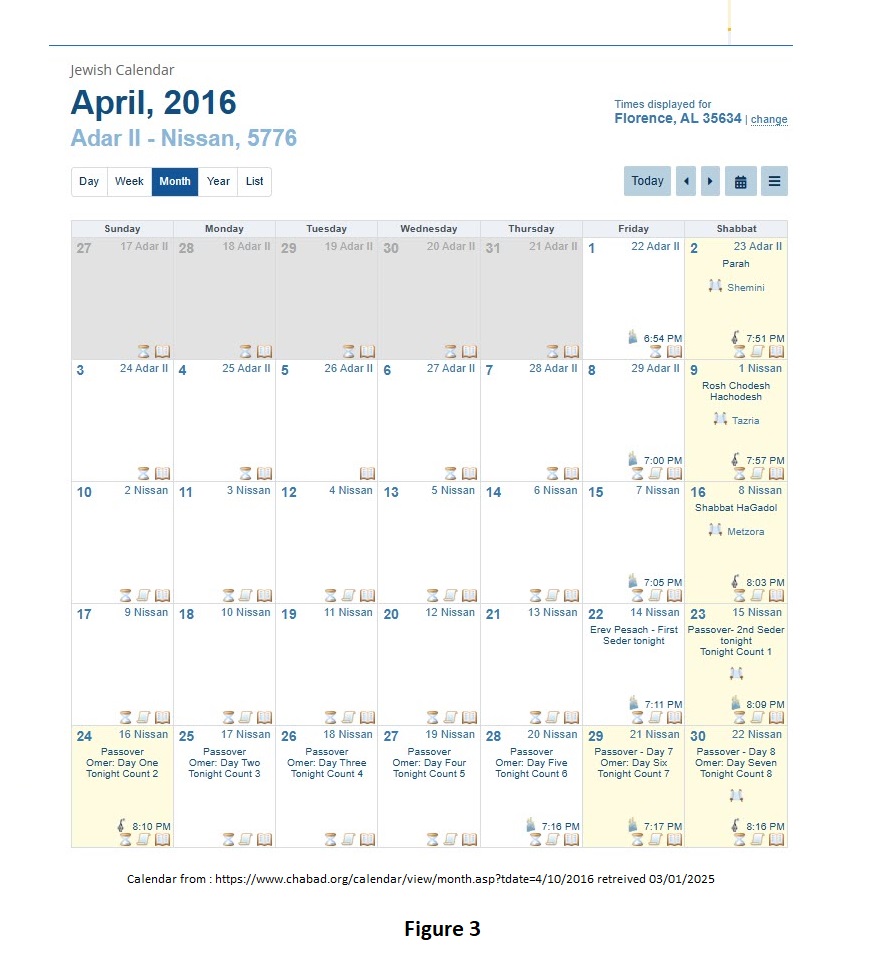
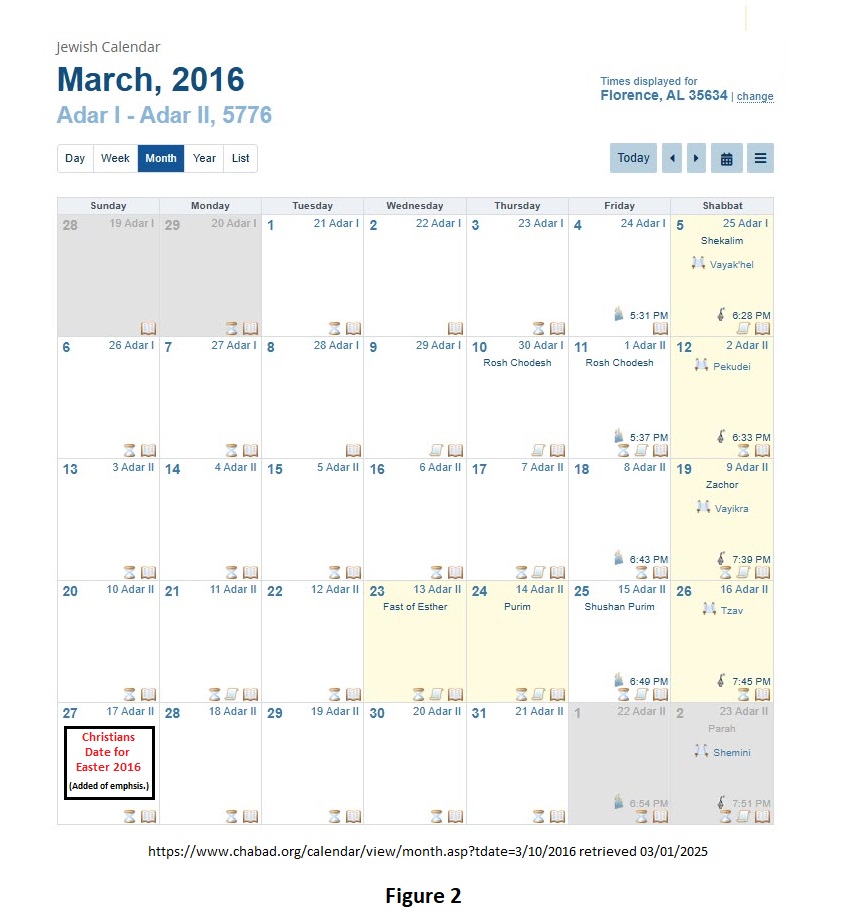
Many of you still have no clue to as to how to interrupt the differences between the Gregorian Date and the Jewish date. Don’t worry few people do. But there is hope I have created a chart to help you visualize the two calendars together. (For more detailed study refer to the sections on calendars in the Supplemental Information at the end of this article to see how very complicated the Jewish calendar is from their own websites.)
So what do you need to know? The overlapping of the hours in our day with the hours of the Jewish day must be understood in order to fully understand what Jesus meant when He said, “For as Jonas was three days and three nights in the whale’s belly; so shall the Son of man be three days and three nights in the heart of the earth.” Matthew 12:40 KJV. In Figure 5, I show a rough comparison of the Jewish day and our Gregorian day. The top row of hours is a Gregorian 24 hour day illustrated for three days. Below it is the hours for a little over three and a half days of Jewish days. Carefully study Figure 5 as I continue and try to explain the details.

As the Jewish websites tells us their calendars and days are very complex and even the hours in each day are different lengths. To be technically correct and find a date and time during any given day of the year we would have to make a chart like Figure 5 for every day of the year. I have made this chart for us, “simple minded people”. The chart is technically correct but for this illustration I am “Not” using the actual date of Jesus crucifixion. I have chosen the day of the equinox. As I explain in more detail in the Supplemental Information at the end of this article, only on the day of an equinox do the Jewish hours and a Gregorian hours come close to being the same. Using this equinox date makes my chart look nice and uniform and easy to explain. It also helps us see how the Jewish writers of the Bible in Jesus day were explaining the timeline of the crucifixion using their “Clock”. Their clock ticked to a different tune than our clock as we will see.
After studying Figure 5, we can now summarize all the facts about how Jesus was in the grave three days. Jesus died on Thursday afternoon our time, 14th day of Nissan which was Passover day. Since He died before sundown Jews count His day of death as Thursday, 14th day of Nissan. Jesus’ First Day in the Grave. He was buried in a rush without all the normal preparations. In Luke 23:54-56 KJV it says; “54And that day was the preparation, and the sabbath drew on. 55 And the women also, which came with him from Galilee, followed after, and beheld the sepulchre, and how his body was laid. 56 And they returned, and prepared spices and ointments; and rested the sabbath day according to the commandment.”
Friday our time, the 15th of Nissan on the Jewish calendar, was a special Sabbath in which no one could come to the grave or do work so the disciples did not come to the grave that day. This was the First Night in the Grave and the Second Day in the Grave.
Saturday our time, 16th of Nissan was the normal Sabbath and the same rules were in place as Friday, no travel or work. This was the Second Night in the Grave and the Third Day in the Grave.
Sunday morning our time, 17th of Nissan, was the first day of the normal week. Jesus arose sometime before daylight Sunday morning our time. We know this because in John 20:1-2 we are told; “1The first day of the week cometh Mary Magdalene early, when it was yet dark, unto the sepulchre, and seeth the stone taken away from the sepulchre. 2Then she runneth, and cometh to Simon Peter, and to the other disciple, whom Jesus loved, and saith unto them, They have taken away the Lord out of the sepulchre, and we know not where they have laid him.” John 20:1-2 KJV. This was the Third Night in the grave. Remember that at daybreak all of the evening hours or night hours for the Jewish day are complete.
We see the term “day” here is being uses to describe the daylight hours of the Jewish day. And the dark hours are termed as “night.”
In conclusion,
I hope to have shown you all the evidence showing how Jesus was in the grave for three days and three nights just as He said. Jesus died afternoon on the 14th of Nissan, this was his “first day in the grave”. Jesus remained in the grave on the 15th of Nissan all day, that is “evening and morning” as we read in Genesis chapter one. This now is his “first night in the grave”, and his “second day in the grave”. Jesus again remained in the grave on the 16th of Nissan. That evening was the “second night in the grave” for Jesus and at sunrise this made his “third day in the grave”. Finally, on the 17th of Nissan, that is after the sunset on the 16th, Jesus spent his final day in the grave, arising before sunrise on the 17th of Nissan. This makes his “third night in the grave” and he has already spent “three days in the grave” just as Jesus said he would.
We need to notice another thing about word usage and the order of the events. We read; “40For as Jonas was three days and three nights in the whale’s belly; so shall the Son of man be three days and three nights in the heart of the earth.”Matthew 12:40 KJV. Notice that “day” comes before “night” because Jesus died during the first “day”, daylight hours of the fourteenth. In Genesis “night” came before “day”. From this we can deduce that the Jews and people of Jonah’s day thought of these concepts the same way.
So what are the real important precepts here, the timing of the crucifixion of Jesus?
No, the timing of the crucifixion of Jesus is not the real important part of the study. This was just relatively unimportant but interesting point that people have quibbled over for centuries. The real truth of the matter is that the cross and the punishment Jesus went through that day, was our punishment for our sins by the perfect sacrifice, Jesus.
So, why can we not just be beaten unmercifully, mocked, scorned, ridiculed, and hung on a cross, sacrificed on an altar or some other form of human punishment for our own sins, then die for a few days and then be made right with God? We, all of mankind including Adam and Eve have violated the perfection of God. Sin of any kind can never be in the Holy Presence of God without being judged. Let’s look at a human example.
What if you or I, walked right off the street in perfect health into a surgery suite that was about to have surgery on one of your family members and started looking at everything picking things up and handling them. What would happen to you? You would immediately be removed and the surgery cancelled until the room could be purified again. You would never be allowed to enter surgery suite until you were cleansed to the standard required to be in that environment just like the doctors, nurses and any equipment used in the surgical suite. That is the way it is with God’s Holy Presence. God the Father is sinless perfection, nothing can be allowed to be in His presence without being cleansed or judged and cast out of his Holy Presence.
Since God has created everything that has ever been created where does God put those who willingly rebel and sin against God, that is to be removed from His Holy presence? So, we need to look at these precepts of sin and the Holy presence of God and see what God says about them as God has recorded in His Bible for us. These answers can be found in the article “God’s Plan of Salvation” here on the “Times of the Gentiles Outreach” website continue reading by clicking on this link. https://totgor.com/2025/02/25/plan-of-salvation/
Additional information about calendars can be found in the following section “Supplemental Information” that follows.
Supplemental Information
Calendar Parameters: Why Are They So Complex?
The first thing we must consider in understanding time systems is the earth’s rotation on its axis (Night and Day). Here we find our first problem; a day (the single rotation of the earth) is not an exact round number in our numbering system. According to timeanddate.com; “a sidereal day is 23 hours, 56 min, 4 sec long”[1]. Since a day is not exactly 24 hours long the day must be adjusted or corrected periodically. In the Gregorian calendar, which we use today, this adjustment is made periodically by adding a day to February. The year of this adjustment is called a Leap Year. In addition to the earth’s rotation on its axis there is the earth’s rotation around the sun which must be considered.
A solar year (tropical year) is when the earth revolves around the sun one time. A solar year is approximately 365.24219 days; this is the time from one equinox, to the time the same equinox occurs a year later.[2] Well some may say, we can always use the equinox as a reference. What most people do not understand is the equinox is equal in “name only”. This is very complex, to truly understand this, see timeanddate.com[3] web site for the complete details. In short, the equinox varies by latitude and is on different days in different latitudes.
Another reference which early man could observe as a time frame is the lunar cycle. This is the changes in the appearance of the moon from, new moon to full moon and back. These changes are consistent, but do not follow an exact number days. The lunar cycle is 29.5306 days long. This again does not divide into equal days therefore must be periodically adjusted for the partial day.
Next, we must consider the seasons of the year. These are repetitive, but as we all know, weather is not consistent and man cannot depend on these changes for time references. However, since seasons occur in predictable order each year a calendar should reflect the seasons consistently with the same months each year.
Along with these four observable events early man observed the stars and constellations to determine time cycles and repetitive events.
The Jewish Calendar
The making and the maintenance of a calendar took a lot of knowledge, knowhow and daily effort for early mankind and the Jewish nation. Since I am not an expert on any of these subjects I will depend on chabad.org for a short simple description of their calendar then I will cover the topics in more detail.
They State:
“Since Biblical times, various astronomical phenomena have been used to establish uniquely Jewish definitions for the day and its hours, the months and the year. The length of days and hours vary by the season, controlled by the times of sunset, nightfall dawn and sunrise. The months and years of the Jewish calendar are established by the cycles of the moon and the sun. Though the months follow the lunar cycle, the lunar months must always align themselves with the seasons of the year, which are governed by the sun. Thus, the Jewish calendar is “Luni-Solar.” The discrepancy between the solar year(365 days) and the lunar year (354 days) was resolved by every so often adding a thirteenth month to the year, to form a “leap year.” In the early times of our history, the High Court (Sanhedrin) in Jerusalem was assigned the task of determining the beginning of each month and the balancing of the solar with the lunar years. They relied on direct observation of the New Moon, and astronomical data, and other considerations. In the fourth century after the Temple’s destruction, however, when oppression and persecution threatened the continued existence of the Court, a fixed calendar was instituted – based in the Sanhedrin’s closely guarded secrets of calendric calculation (emphasis added). This is the permanent calendar according to which the New Moons and festivals are calculated and celebrated today by Jews all over the world. Like the original system of observation, it is based on the Luni-Solar principle. It also applies certain rules by which complex astronomical calculations are combined with the religious requirements into an amazingly precise system.”[4]
With this in mind we can now look closer to the details of Jewish time keeping.
Jewish Definition of an Hour
The Jewish website chabad.org gives information on understanding the Jewish Hour by which the “letter of the Law” must be fulfilled under the Mosaic Laws and the traditions and celebrations of the Jewish nation. Chabad.org says in the Jewish day an “hour” is determined by: “taking the total time of daylight of a particular day, from sunrise to sunset,[5] and dividing it into 12 equal parts. A halachic hour is thus known as a sha’ah zemanit, or proportional hour, and varies by the season and even by the day.”[6] With this knowledge we get a different understanding of when events happened during the Jewish day.
Refer to Figure 1[7] and we can determine the Jewish hour for the longest and shortest days this year based on our current 24-hour day 60-second minute time frame. On June 21, this day has 862.7 minutes. A Jewish hour for this day would be 862.7/12 or 71.89 minutes per hour. On December 20, the day has 595.8 minutes. The Jewish hour this day would be 49.64 minutes long. On the Equinox, the days and night are approximately equal, 12 hours each. On these days one hour would be very close to 60 minutes just as we use today. So on each day each hour is slightly different going from 49.64 minutes on the shortest day of the year, to 71.89 minutes on the longest day of the year. Therefore, the sixth hour and the ninth hour varies in actual hour but reflect the same relative time of “daylight to dark” perspective.
One aspect of Jesus crucifixion was the time He was on the cross:
Matthew states in Matthew 27:45-46: “45 Now from the sixth hour there was darkness over all the land unto the ninth hour. 46 And about the ninth hour Jesus cried with a loud voice, saying, Eli, Eli, lama sabachthani? that is to say, My God, my God, why hast thou forsaken me?”
In John 19:13-14 it says: “13 When Pilate therefore heard that saying, he brought Jesus forth, and sat down in the judgment seat in a place that is called the Pavement, but in the Hebrew, Gabbatha.
14 And it was the preparation of the passover, and about the sixth hour: and he saith unto the Jews, Behold your King!”
These times were not 6 o’clock or 9 o’clock modern time, but was Jewish time based on the sunrise and sunset that day. For most of you the explanation of these differences will be meaningless. For you just think about is as putting a metric ruler next to an imperial (English) ruler. It’s not hard to see when you put them together. So for the math buff here is how it works. For the rest skip down to the next paragraph.
For the math buffs:
This being the case, for my example and explanation I will use this year as the date and see when these hours would occur in relationship to our time frame based on a 24 hour day. The Passover in 2016 is on April 23, 2016. Sunrise is at 6:07 am and sunset is at 7:25 PM which is 13 Hours 17 Minutes and 41 sec.[8] This equals to 797.68 of our minutes of daylight. 787.68/12= 66.473 of our current minutes per Jewish hour. The sixth hour would be 6X66.473=398.8 of our minutes or 6.647 of our hours past sunrise, or just over 6-1/2 hours past 6:07 AM our time. This would be about 12:30 PM our time. The ninth hour would be 9X66.473= 598.25 of our minutes or 9.97 of our hours. This would be about 10 hours past sunrise of 6:07 AM or about 4:07 PM our time. Now some of you will understand the Jewish hour, but many are probably more confused than ever. Simply stated the Jewish hours is the time of “daylight” divided into 12 equal parts each part being one hour, this causes the length of an hour to change each day. That is, each day of the year has a different length hour.
So for the rest of us I have a chart that will visually show how they are different, see Figure 5. We need to understand about the differences in the Gregorian Year and the Jewish year.
God, thru Moses, established the Jewish month/year system in Exodus 12:1-2 KJV where it says; “1 And the Lord spake unto Moses and Aaron in the land of Egypt saying,2 This month shall be unto you the beginning of months: it shall be the first month of the year to you.” They called this month Nissan, this is approximately March to April on the Gregorian calendar. Now you may ask why two different months? Briefly, as stated earlier, some Jewish years have thirteen months with varying number of days. The months are: Nissan, Sivan, Tammuz, Menachem Av, Elul, Tishrei, Marcheshvan, Kislev, Shevat, and Adar. During the leap year they have both Adar I and Adar II. This is where a detailed study is required to understand how the minute details of their calendar works and why the Sanhedrin made constant changes to it and has elaborate rules to make it work. This is beyond the scope of this article. What we need to recognize is the relationship of the Month of Nissan to our present day calendar. For a closer look study Figure 2.
The calendar in Figure 2 shows the year, month and day for March 2016 of our Gregorian calendar. Notice the Jewish calendar is overlaid on the Gregorian calendar. Notice how Adar I ended on March 10th and Adar II (13th month, a leap year) starts on March 11th. We see from this our first complication of converting dates. If we read a statement in the bible like; “The word of the Lord came to me in the twelfth month (Adar I) on the thirtieth day of the month…” in our minds we are thinking December thirtieth. We are planning that New Year’s Party for tomorrow night the 31th. But wait this is really our March 10th. The Jews would be starting a new year in a “Normal” year. But wait, its 2016 (our year) which means the Jewish year is a leap year. They have a whole month before they enter a new year and have their party.
Are you starting to see why so many bible teachers and cults get their date so wrong! You will soon be able to discern these differences in your Bible studies.
Notice the “Text Box” I placed on the calendar in Figure 2. The Christian world celebrated Easter Sunday (Passover week) on March 27, 2016. This is Adar II 17, 5776 on the Jewish calendar, again the 13th month of their calendar.
Now look at Figure 3 and notice we are now in our month of April 2016. April 9, 2016 was the start of the Jewish calendar year, Nissan 1, 5776. They are celebrating Passover and the Feast of Unleavened Bread a whole month later than our celebration of Easter Sunday, during 2016. They celebrate from April 22nd through April 30th.
How the Jews (and the Old Testament) and the New Testament describes the Passover and the Feast of Unleavened Bread is critical to our understanding of Jesus crucifixion. Big Note: The names of the months have changes through the exile. Different versions of the Bible will use different names for the months such as Nissan. Nissan is referred to as Abib or Aviv in some translations.
[1] www.timeanddate.com/astronomy/equinox-not-equal.html 02/03/2016
[2] http://en.m.wikipedia.org/wiki/Tropical_year 02/03/2016
[3] www.timeanddate.com/astronomy/equinox-not-equal.html 02/03/2016
[4] www.chabad.org/libary/article_cdo/aid/55194/jewish/Introduction.htm 02/09/2016
[5] “Sunrise and sunset” is a very special topic of Jewish time concepts. Chabad.org footnotes this by saying “according the other opinions, from dawn (“alot hashachar”) until three stars appear in the sky (“tzeit hakochavim”).02/03/2016
[6] www.chabad.org/libary/article_cdo/aid/526872/jewish/Hours.htm 02/03/2016
[7] www.timeanddate.com/sun/usa/birmingham?month=12&year=2016
[8] www.timeanddate.com/sun/usa/birmingham?month=12&year=2016
